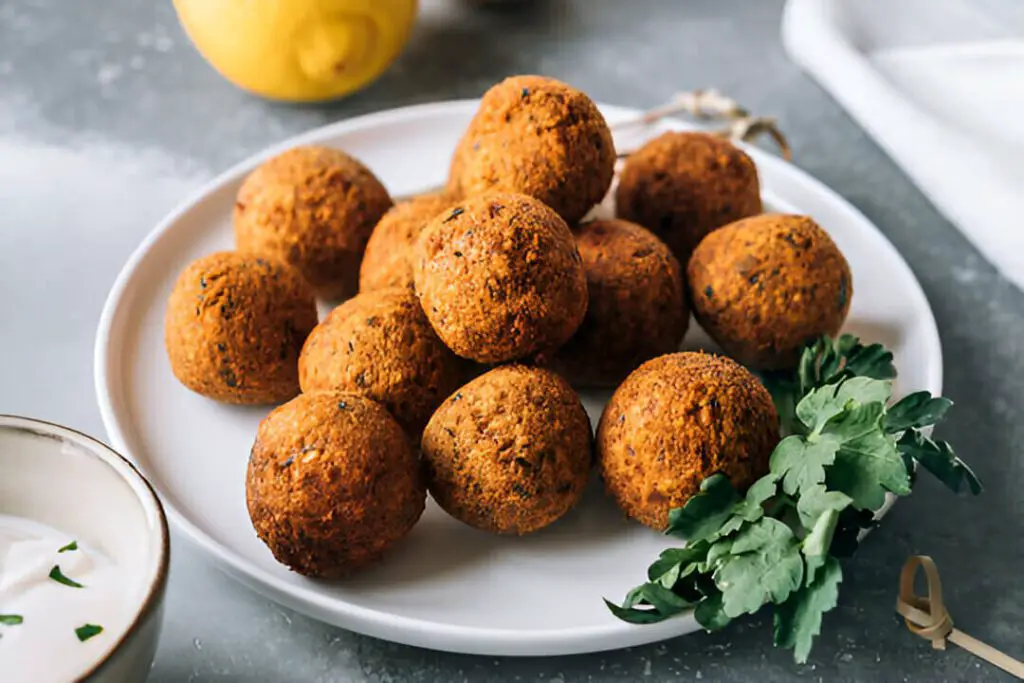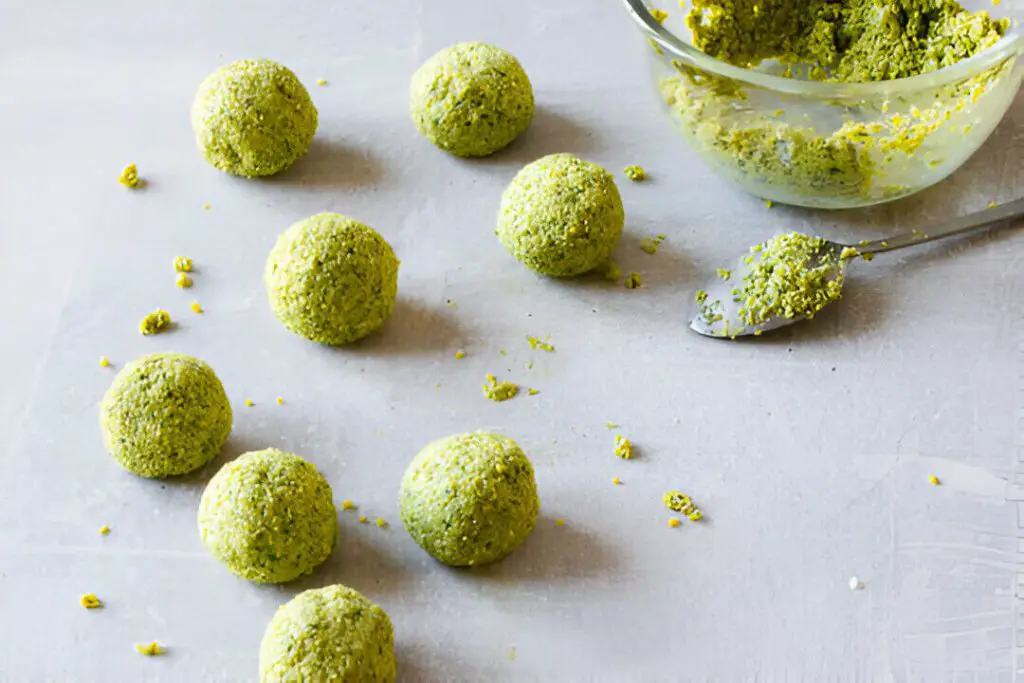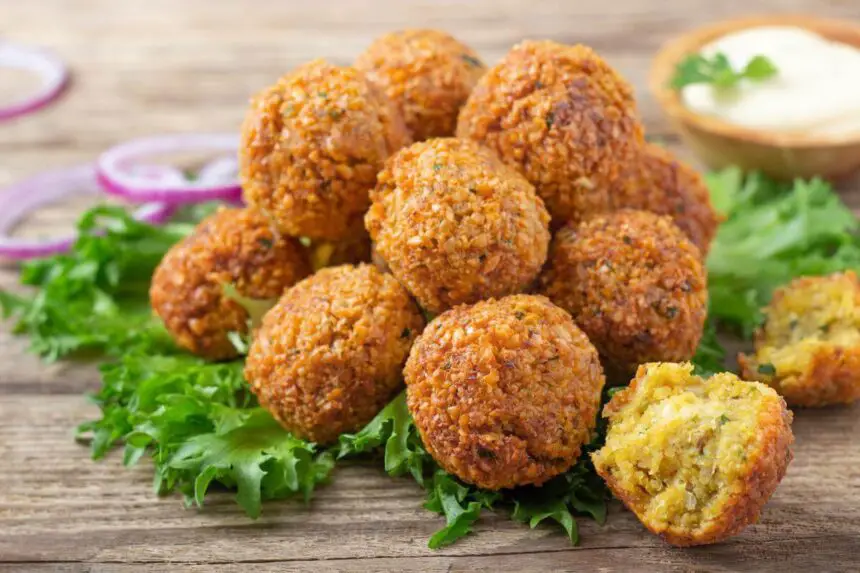Falafel. That delightful Middle Eastern treat. It’s crunchy on the outside, soft on the inside, and packed with flavor. But what about our feline friends? Can cats eat falafel? This might seem like an odd question, but for cat lovers who enjoy sharing their favorite foods, it’s worth exploring. Let’s dive into the world of cats and falafel and see if these two can mix.
What is Falafel?
For those who might be new to this tasty treat, falafel is a deep-fried ball or patty made from ground chickpeas or fava beans, often mixed with herbs, spices, and onions. Originating from the Middle East, it’s now a popular dish worldwide, often served in pita bread or with salad and tahini sauce. It’s crispy on the outside, soft on the inside, and packed with flavor.
Ingredients in Falafel
To understand if falafel is safe for cats, we need to look at its ingredients:
- Chickpeas/Fava Beans: These legumes form the base of falafel. Chickpeas are rich in protein and fiber but also contain high levels of starch.
- Onions and Garlic: These are common ingredients in falafel recipes. They add flavor but can be toxic to cats.
- Herbs and Spices: Cumin, coriander, parsley, and cilantro are often used. While not toxic, they might upset a cat’s digestive system.
- Salt and Other Seasonings: Too much salt isn’t good for cats, and other seasonings might not be safe either.
- Oil: Falafel is deep-fried, meaning it’s cooked in a lot of oil, which isn’t ideal for a cat’s diet.
Can Cats Eat Falafel?

In short, cats can not eat falafel. While a tiny, accidental nibble might not cause immediate harm, falafel contains several ingredients that can be dangerous for cats, particularly onions and garlic. Even in small amounts, these can lead to serious health issues.
Why Onions and Garlic are Dangerous
Onions and garlic contain compounds called thiosulfates, which are toxic to cats. These compounds can damage your cat’s red blood cells, leading to a condition called hemolytic anemia. Symptoms of onion or garlic poisoning include lethargy, weakness, reduced appetite, and even collapse. Given that even a small amount can be harmful, it’s best to keep these foods out of your cat’s reach.
Other Ingredients
- Chickpeas and Fava Beans: While not toxic, they’re not easily digestible for cats. Consuming them can lead to gastrointestinal upset, including diarrhea and vomiting.
- Herbs and Spices: Cats have very sensitive digestive systems, and strong herbs and spices can cause stomach irritation or more severe digestive issues.
- Oil: The high-fat content from deep-frying can cause pancreatitis in cats, a painful and potentially serious condition.
Can Cats Eat Chickpeas?
Chickpeas, the star ingredient in falafel, can be a tad tricky for our cats to digest. While they’re not toxic, they’re not a regular part of your kitty’s diet. Cats are obligate carnivores, which means their digestive systems are built for a meaty feast. Chickpeas are high in protein, but they also pack a punch of other compounds that may not sit well with your cat’s tummy.
Feasting on too many chickpeas can lead to indigestion, bloating, diarrhea, and potentially, weight gain and diabetes. So, if your cat decides to have a nibble, it’s not the end of the world, but it’s best to keep it as an occasional treat.
What to Do if Your Cat Eats Falafel?
If your cat has somehow managed to gobble up some falafel, don’t panic. Here’s what you should do:
- Monitor Your Cat: Keep an eye on them for any signs of distress, like vomiting, diarrhea, lethargy, or any changes in behavior.
- Call Your Vet: If you notice any symptoms or if your cat ate a significant amount, contact your veterinarian immediately. They can provide advice specific to your cat’s situation and may recommend bringing your cat in for a check-up.
- Prevent Future Incidents: Keep falafel and other potentially harmful foods out of your cat’s reach. Consider storing them in sealed containers or placing them in areas your cat can’t access.
Healthier Alternatives
If you’re keen on sharing a treat with your cat, there are plenty of safer alternatives. Here are a few ideas:
Cooked Meat
- Chicken: Plain, cooked chicken can be a great protein source.
- Turkey: Similarly, plain turkey is a healthy option.
- Fish: Cooked and unseasoned fish is another cat-friendly treat.
Cat-Safe Vegetables
- Pumpkin: Great for digestion.
- Peas: A good source of vitamins.
- Carrots: Provide fiber and vitamins.
Homemade Cat-Friendly Falafel

If you’re determined to treat your cat to some falafel, you could try making a special version just for them. Here’s a simple recipe idea:
Ingredients:
- Cooked chicken or turkey (shredded)
- A small amount of mashed pumpkin or sweet potato (for binding)
- A sprinkle of catnip or dried cat-safe herbs
- A tiny bit of olive oil
Instructions:
- Mix the shredded chicken or turkey with the mashed pumpkin or sweet potato until you get a dough-like consistency.
- Add a sprinkle of catnip or dried herbs to the mixture.
- Form the mixture into small balls or patties.
- Instead of frying, bake them in the oven at a low temperature until they’re firm.
Remember, even with this modified recipe, treats should only make up a small part of your cat’s diet. The majority of their nutrition should come from high-quality cat food.
Homemade Cat Treat Recipe
Feeling adventurous and want to make your cat a special treat? Here’s a simple recipe for homemade cat treats that’s sure to get them purring.
Tuna Cat Treats
Ingredients:
- 1 can of tuna in water (drained)
- 1 egg
- 1 cup of oat flour
Instructions:
- Preheat your oven to 350°F (175°C).
- In a bowl, mash the tuna until it’s a smooth consistency.
- Add the egg and mix well.
- Gradually add the oat flour until you get a dough-like consistency.
- Roll the dough into small balls and place them on a baking sheet lined with parchment paper.
- Flatten the balls slightly with a fork.
- Bake for 10-12 minutes or until they’re golden brown.
- Let them cool completely before giving them to your cat.
Store these treats in an airtight container and they should last about a week.
Why Do Cats Want to Eat Our Food Anyway?
If you’ve ever had a cat beg for your food, you know how persuasive they can be. But why are they so interested in what we eat? Here are a few reasons:
- Curiosity: Cats are naturally curious creatures. They want to know what you’re eating and if it’s something they might like too.
- Smell: Our food often smells stronger and more interesting than their cat food, which can pique their interest.
- Social Eating: Cats often want to be part of what their humans are doing, including eating. If you’re enjoying a meal, they might want to join in.
What Should Cats Eat?
To keep your cat healthy and happy, it’s important to feed them a balanced diet that meets their nutritional needs. Here are some basics:
- High-Quality Cat Food: Look for food that lists meat as the first ingredient and is free from fillers like corn and soy.
- Protein-Rich Diet: Cats need a lot of protein in their diet, so make sure their food is rich in meat-based proteins.
- Hydration: Wet cat food can help keep your cat hydrated. If your cat prefers dry food, make sure they have plenty of fresh water available.
Foods to Avoid
While we’re on the topic of diet, let’s go over some foods that you should never feed your cat:
- Chocolate: Toxic to cats and can cause serious health issues.
- Alcohol: Even a small amount can be dangerous.
- Caffeine: Can lead to restlessness, rapid breathing, and heart palpitations.
- Dairy Products: Many cats are lactose intolerant, and dairy can cause digestive problems.
- Grapes and Raisins: Can cause kidney failure in cats.
Can Cats Eat Bread?
Okay, so falafel is a no-go for your kitty, but what about bread? Can cats nibble on baked bread without any issues?
The answer here is a bit complicated. Cats can consume baked bread in moderation, and it doesn’t pose a significant health risk. However, it’s essential to be cautious, as some cats may experience digestive problems after eating bread.
It’s important to note that bread should not be a regular part of your cat’s diet, mainly due to some potential health concerns. If your cat has underlying health conditions like heart disease, kidney issues, or diabetes, it’s best to avoid bread altogether.
Can Cats Eat Fruits?
Now, let’s talk about fruits and your feline friend. Can cats nibble on fruits like raspberries and strawberries?
Raspberries for Cats
Raspberries, in general, are considered safe for cats and pose no immediate health risk. However, whether your cat takes a liking to them or not can vary from one feline to another. Cats have diverse tastes, and some might find raspberries appealing, while others may not give them a second glance.
While raspberries are generally safe for cats, it’s crucial to offer them in moderation. Feeding your kitty a large amount of raspberries could lead to digestive issues, like vomiting or stomach discomfort. To be on the safe side, limit their raspberry intake to one or two berries per week, if they enjoy them.
Strawberries and Cats
Strawberries are another fruity curiosity for cat owners. Are they safe for your feline friend?
Strawberries, while not toxic to cats, come with their own set of concerns. They’re high in natural sugars, which may not align with your cat’s dietary needs. Cats are obligate carnivores, and their systems are designed to thrive on a meat-based diet. Offering fruits like strawberries, with their high sugar content, could potentially lead to health issues.
If you’re curious about cats and strawberries, it’s a good idea to consult your vet before letting your kitty have a taste. When offering strawberries to your cat, make sure to wash them thoroughly and remove the leaves. Some cats might be allergic to strawberries, so observe their reactions carefully.
Blueberries
If you’re looking to introduce some fruits into your cat’s diet, consider blueberries. They’re a rich source of vitamin C, folate, potassium, manganese, antioxidants, and fiber – all of which can benefit your furry friend. Offering two to three blueberries as an occasional treat can be a delightful way to keep your cat healthy.
Can Cats Eat Potatoes?
Now, what about potatoes? Can your cat nibble on this starchy delight?
Potatoes are a bit of a hit-and-miss with cats. Some cats may occasionally indulge in potatoes, but not all of them do. If you want to offer your pet a taste of this starchy treat, ensure it’s peeled and roasted without using any fat, spices, or salt. Keeping it plain and simple is the way to go.
Final Thoughts
While falafel is a delicious and healthy snack for humans, it’s not suitable for cats. The ingredients, particularly onions and garlic, pose a significant risk to their health. As responsible pet owners, it’s crucial to keep our feline friends safe by ensuring they only consume foods that are appropriate for them.
Remember, cats have different dietary needs than humans, and what’s healthy for us can sometimes be harmful to them. Stick to cat-safe treats and foods, and always consult with your vet if you’re unsure about what your cat can eat.
So, the next time you’re enjoying a plate of falafel, resist those pleading eyes from your kitty and offer them a safe, feline-friendly treat instead. Your cat will thank you with purrs and cuddles, and you’ll have peace of mind knowing you’re keeping them healthy and happy.


